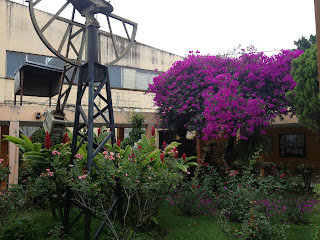The last day of the 2012 conference ended with a party given by next year's host, El Salvador. A group of Salvadoreans living in Sydney made delicious tamales and other treats from their home country, and performed a traditional dance.
INPUT 2012 seemed to go by in a flash – hard to believe
Friday was the last day. I hope we can keep up with folks and report on the
great things everyone’s doing via this blog. Message to readers – don’t be shy
about adding comments!
For me, Friday was another smorgasbord of TV
treats. I began at the session called “Mobile Phones as Witnesses: User
Generated Content in the News.” The first program at the session was “You Should Have Stayed
at Home,” a CBC production constructed from mobile phone pictures and video
taken during the 2010 G20 Summit in Toronto, when violent riots took place. The
discussion, led by CBC producers Lynette Fortune and Jim Williamson, centered
on the ways in which UGC can be verified and held to journalistic
standards. Fortune explained that she had met every content provider in person
and checked their media against a list of qualifying criteria that she
developed. Another means of
verification was to compare several videos of the same event, shot from
different angles. More than one camera shooting the same event = truth.
In general, though the network
was able to pay only a nominal fee for footage, people were very cooperative
and eager to share their media, providing the producers with many hours of
recordings. Fortune found the videos first, on You Tube, and then went
looking for the people who shot them. In one case she found only a photo of a
young man being beaten by the police. After the show was broadcast several
people came forward with video of the incident.
The other program presented in this session was “Mega
Tsunami: Hidden Perils,” from NHK. The producers of this documentary used UGC
to tell the story of the terrifying mega tsunami that hit Japan in March 2011, when
the destructive power of water was followed by fires that broke out on the
oil-soaked seas. The video shot by
witnesses pointed the producers to personal stories, making the coverage
extremely effective and poignant. One member of the audience raised the
question of the quality of the shooting, which of course isn’t in the same
category as professionally shot media. But the consensus seemed to be that UGC
adds an invaluable immediacy to news and documentaries and works best when
verified and contextualized by professional producers and journalists.
In the afternoon I attended two sessions, beginning with “To
Academic, Too Sophisticated? Delivering Bulky Content.” This session began with
another NHK program, “Feast of Exquisite Beauty,” employing a well-known
photographer to analyze Vermeer’s “Girl with a Pearl Earring,” and try to
replicate the painting in a photograph. Through his efforts to recreate
Vermeer’s masterpiece, the photographer – along with the audience - discovers
revealing details about the painting.
Although it had an annoying (at least to Western ears) “voice of God”
narrator, the show helped me see “Girl with a Pearl Earring” in a new and
unforgettable way and made me wish that we had more adventurous arts
programming in the U.S.
Next up was Canadian Andrea Dorfman’s animation, “Flawed,” a
beautiful short piece about personal identity. Unfortunately, the filmmaker
wasn’t able to attend. It has long been a basic tenet of INPUT that someone
from the production team must accompany the program and I hope this rule will
be upheld in the future. Without one of the producers in attendance the quality
of the discussion is completely altered, and not for the better.
Finally, I went to the “10 Ways to Involve Your Audience and
Use Social Media” session. Here I saw presentations from Switzerland and ARTE
that made me very envious. One is a virtual tour of a street in Zurich in which
tweets pop up like thought bubbles as the user moves down the street – a lot of
fun, and like nothing I’ve seen before:
www.360langstrasse.sf.tv. ARTE’s
site is the partner site to the program “Photo for Life,” which I wrote about
on Tuesday. Exceptional!
So – another great week of debate and inspiration. I’m thankful to have been part of INPUT for the last 3 years. I hope I can apply a
lot of what I’ve absorbed here in Sydney to my own work back home.






























